
- Source: HYPERALLERGIC
- Author: DANIEL GERWIN
- Date: NOVEMBER 09, 2019
- Format: DIGITAL
Brian Belott’s Satirical Modernist Grids
In his current exhibition, Belott degrades the modernist grid, making it lumpy with swollen puffs that participate in the artwork’s visual order while satirizing it.
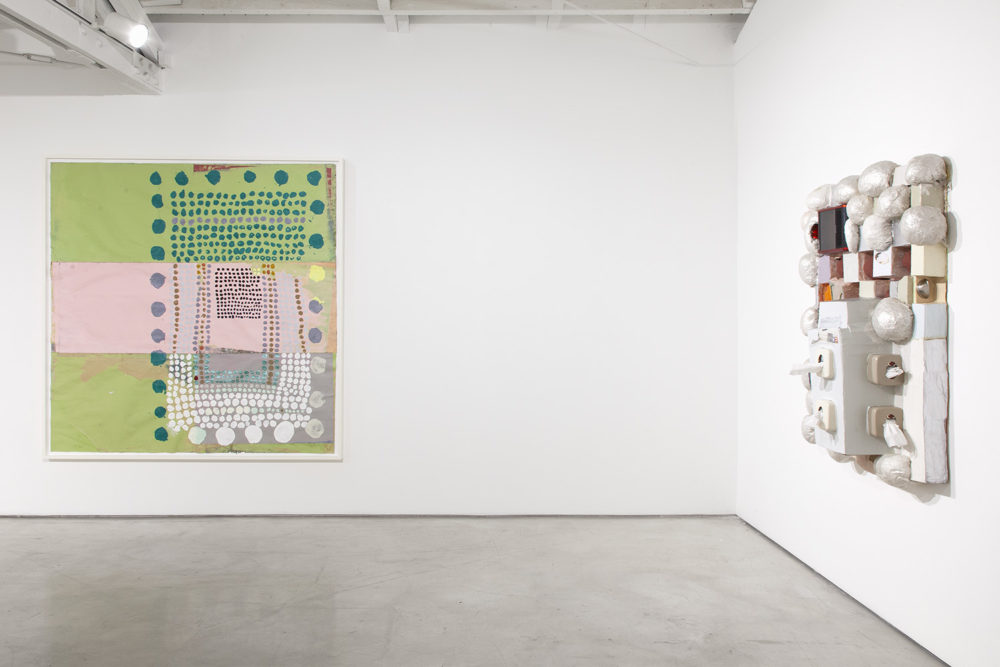
Installation view
Can Opener Door Stop, 2019
Photograph courtesy of Morán Morán
LOS ANGELES — In a 2017 interview in Marfamily, Brian Belott describes his approach to art: “The problem is that part of me is a formalist who loves Mondrian and Agnes Martin and wants to make something so empty, and so clean and crisp, but then the other half of me is someone who would set the Mondrian on fire and is a dadaist. For me, I call it the hermaphroditic principle, the combination of opposites.”
Mondrian is indeed everywhere in Can Opener Door Stop, Belott’s current exhibition at Morán Morán, but only if you imagine the 20th-century master’s paintings infested with puffball mushrooms. Three tondos grouped on the back wall conjure Mondrian most directly. Each is divided into a regular grid pattern that is abruptly cut off by the circle’s edge. The compositions are reminiscent of Mondrian’s diamond-shaped canvases, such as “Tableau No. IV” (1925), in which vertical and horizontal lines, and blocks of color, are interrupted by the canvas’s diagonal boundaries. The squares that compose Belott’s grids are equal in size but vary in color. They are intercepted not only by the tondo’s perimeter, but also, internally, by “puffs,” the name Belott gives to the lumpy blobs of cotton batting that alternate in a checkerboard pattern with the squares. The puffs bulge from the surface like boils on a body, but, coated in bright metallics, pastels, or glitter, they suggest play or amusement more than illness. As a group, the tondos remind me of wheels on a clown car.
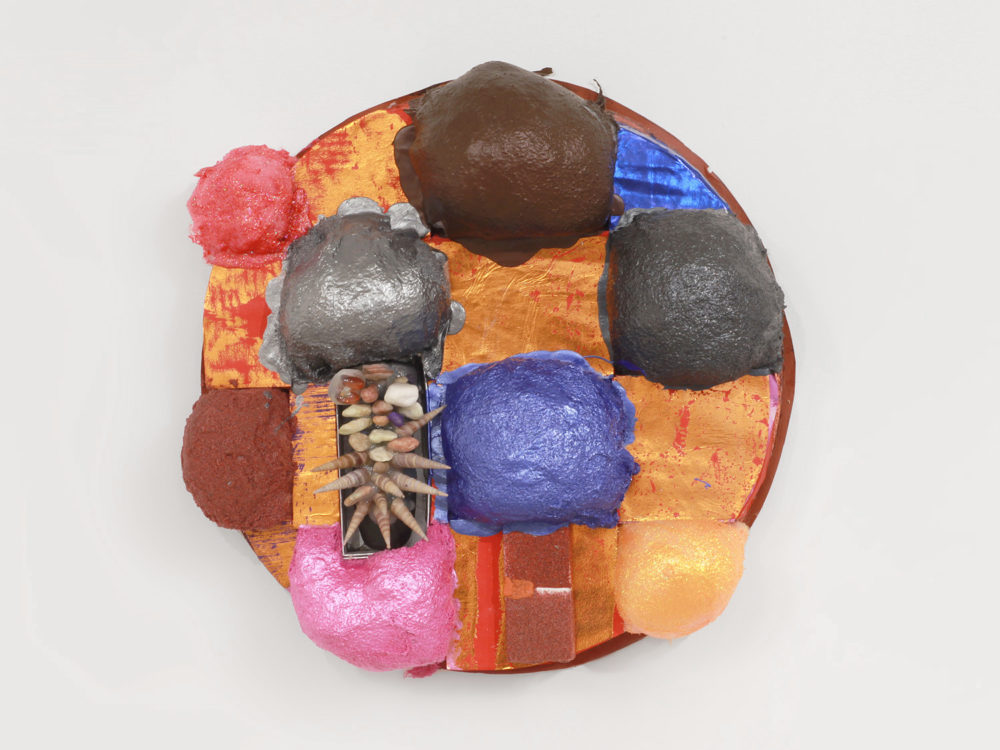
Brian Belott
Untitled (tondo puff with spike remote), 2019
Cotton batting, colorfast paper, acrylic paint, matte medium; remote control with matte medium, colored sand and stones
20 x 20 x 6 inches
(50.8 x 50.8 x 15.2 cm)
Photograph by Dan Bradica

Brian Belott
Untitled (tondo puff with green remote), 2019
Cotton batting, colorfast paper, acrylic paint, matte medium; remote control with matte medium, colored sand and stones
20 x 20 x 6 inches
(50.8 x 50.8 x 15.2 cm)
Photograph by Dan Bradica
A painted television remote is recessed within each tondo, like the figure of a saint in a niche, its buttons are covered in pebbles or shells, as though the object has regressed to a pre-technological state — or a kid decorated it with whatever might be on hand. This gesture is in keeping with Belott’s longstanding fascination with children’s drawings and paintings (his 2017 exhibition at Gavin Brown’s Enterprise comprised a large archive of children’s art).
The tondos are accompanied by eight large rectangular works, most following the same relief grid format, with independent mixed-media clusters in some cases. Typical of Belott’s practice, a range of objects are integrated into the paintings, including bowls of plastic fruit, a taco tray, boxes of tissues, a space heater, a lemon juicer, fake corn cobs, a folding chair, and a dispenser of hand sanitizer. These items all address the needs of the body: to be warm, clean, and rested; to sneeze or wipe away tears (visitors are welcomed to take tissues from the paintings); and to eat — the foods are fake, but they make the point. Belott seems to be thinking about nurturing, in the sense of being physically and emotionally cared for, or caring for others, as well as feeding ourselves creatively, as we do with art. Both senses are apparent in “Untitled (corn puff)” (2019), a lemon-yellow and white painting based on his grandmother’s kitchen: Grandparents’ role is to provide their grandchildren with love, food, and toys, while the kitchen is the nutritive, and emotional, center of many homes.
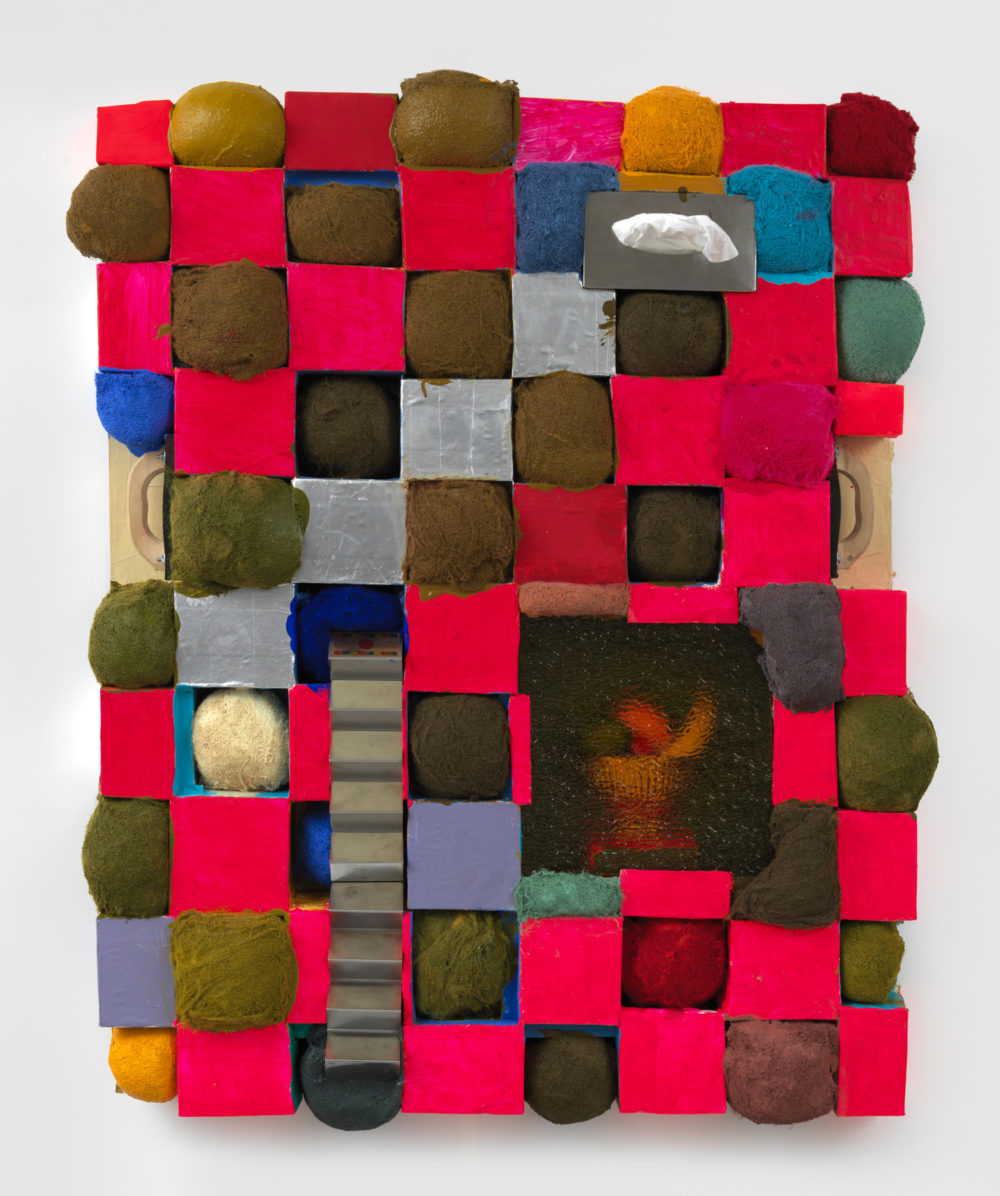
Brian Belott
Untitled (fruit puff 2), 2019
Cotton batting, colorfast paper, acrylic paint, matte medium, fake fruit, tinted plexiglass, handles, tissues, and taco trays
60 x 46.5 x 9 inches
(152.4 x 118.1 x 22.9 cm)
Photograph by Dan Bradica
Most of the exhibition’s works have handles attached to their sides that resemble ears, so that the entire painting recalls a pixelated face. Belott added the handles to help art handlers, because his works are fragile and difficult to move, but they also suggest our job as viewers: to get some sort of a grip on these paintings. To do so requires that we connect the dots he has laid out: the sundry items he presents to us within the works in this exhibition, and their grid-based structure.
While some of the objects embedded in the artworks are real and usable (for instance, the tissues), many are either fake or nonfunctional. The taco tray is empty, the food items are plastic, and, along with the folding chair, inaccessible — sealed away behind Plexiglas panels. Likewise, Belott’s puffs are made from the stuff inside pillows, but rather than offer us a place to rest our heads he makes them alien, comical, and bizarre. Perhaps he is hinting that to imagine we might be nurtured by art is a fool’s errand. Most disconcerting is the space heater lodged sideways in “Untitled (heater puff)” (2019), which features a low-tech illusion of flickering flames; Belott’s studio suffered a serious fire in 2018 that destroyed large amounts of his work.
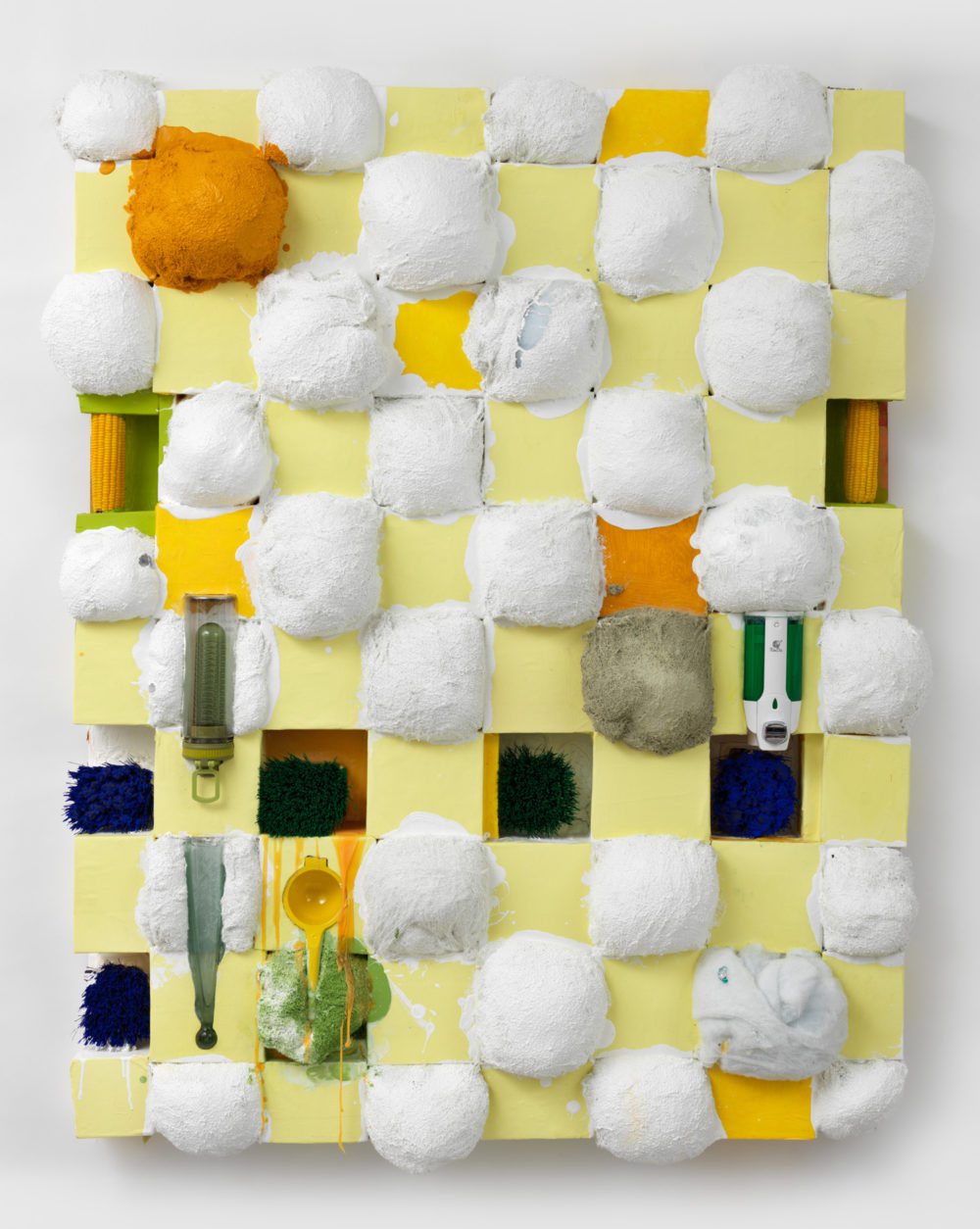
Brian Belott
Untitled (corn puff), 2019
Cotton batting, colorfast paper, acrylic paint, matte medium, brushes, fake corn, wine carafe, hand sanitizer dispenser, and juicer
60.5 x 51 x 9 inches
(153.7 x 129.5 x 22.9 cm)
Photograph by Dan Bradica
Belott’s “hermaphroditic principle” is at play in this exhibition on multiple levels. The entire show hinges on the grid, a device that was foundational to hidebound 20th-century modernism and continues to hold sway over much picture-making today. Yet, he degrades the grid, making it lumpy with swollen puffs that participate in the artwork’s visual order while satirizing it. And though symbols of nurturing are discernible in nearly every work, they are undermined with fakery and internal contradictions. What emerges from these conflicting assertions is an engaging ambiguity, one that prefers to sidestep modernist resolution.
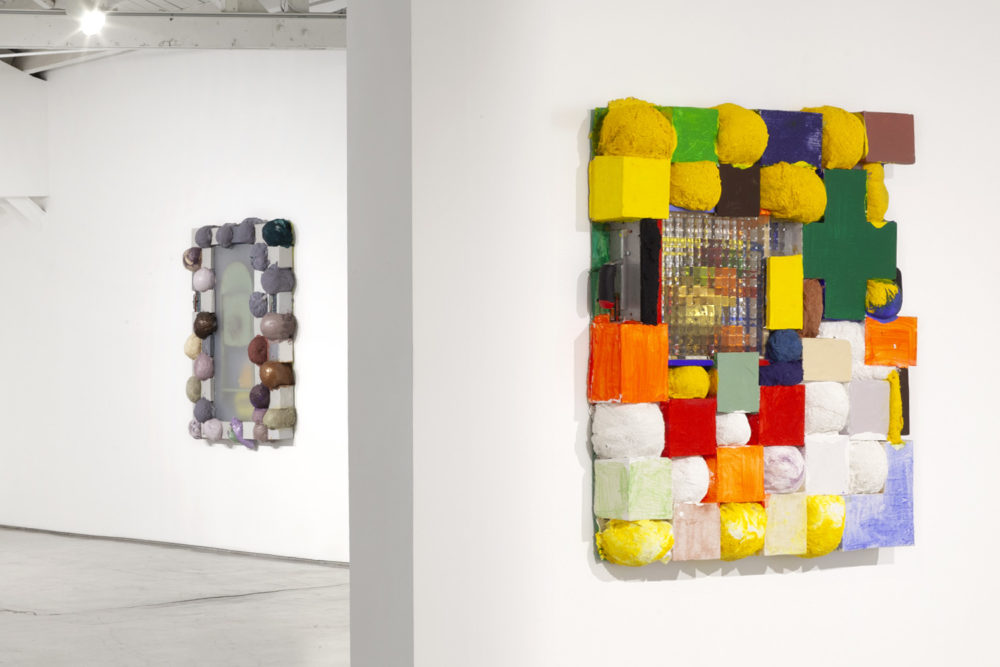
Installation view
Can Opener Door Stop, 2019
Photograph courtesy of Morán Morán
Brian Belott: Can Opener Door Stop continues at Morán Morán (937 North La Cienega Blvd., Los Angeles, California) through November 9.

